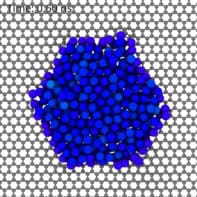Physicists at the University of Vienna in Austria have observed wave-particle duality in a biomolecule for the first time. The team also reports observing wave-like behaviour in the most massive molecule yet - a fluorinated ‘buckyball’. It is twice as large as the previously biggest molecule known to exhibit quantum wave-like behaviour (L Hackermüller et al. 2003 Phys. Rev. Lett. 91 090408).

The classic signature of wave-particle duality in quantum particles is the wave-like interference pattern that is produced when a beam of particles passes through a ‘double-slit’. Researchers have seen wave-particle duality in electrons, atoms and small molecules but it has never been seen in the macroscopic world. This is because the quantum – or de Broglie – wavelength is so small for large objects that we cannot detect their interference in a practical experiment.
In 1999, Anton Zeilinger’s group at the University of Vienna observed wave properties in carbon-60 molecules – buckminsterfullerenes or ‘buckyballs’ – and in their larger counterparts, carbon-70 molecules. At the time, these were the largest objects ever to have exhibited de Broglie wave behaviour but with a diameter of about 1 nm they were still over 6 orders of magnitude smaller than real macroscopic objects.
The Vienna team, now jointly led by Zeilinger and Markus Arndt, has performed a new experiment on tetraphenylporphyrin molecules. These biological molecules are present in chlorophyll and haemoglobin. They have a diameter of about 2 nm (figure 1), which is over twice as big as a carbon-60 molecule.
In the experiment, porphyrin molecules that had been submlimated in an oven were passed through a new type of interferometer containing three sets of diffraction gratings, each separated from each other by about 38 cm. The first grating produces a coherent beam of molecules. The second produces the interference pattern, and the third images this pattern by counting the number of transmitted molecules. The slits in the diffraction gratings were about 500 nm wide and the grating itself had a period of about 1000 nm.
The researchers observed a high-quality interference fringe pattern characteristic of quantum behaviour. “We expected these molecules to couple easily with their environment – which would have ultimately destroyed the interference – but our experiment proves the contrary,” Arndt told PhysicsWeb.
The team then repeated the experiment with a fullerene compound that contains 60 carbon and 48 fluorine atoms (figure 2). “Although the experiments were much more demanding for this object – because of count rate and background noise – we again observed interference fringes,” said Arndt. This molecule is twice as large as carbon-60 and with 108 atoms is the most complex object to show wave-like properties .
The group say their results probe even further the length scales at which quantum behaviour breaks down and classical physics takes over. They now hope to study molecular interference patterns in larger objects like proteins or small nanocrystals by modifying their apparatus. The researchers speculate that in the long term such molecular nanopatterns might even find use as the building blocks in opto-electronic nanodevices or to nanostructure surfaces.




